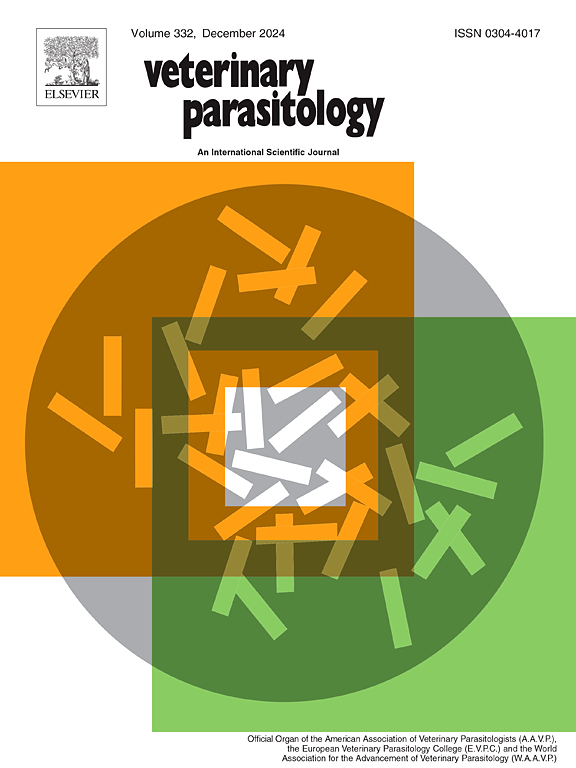Dose and age-dependent effects of Eimeria spp. infection on cytokine and intestinal integrity gene expression in broiler chickens
IF 2.2
2区 农林科学
Q2 PARASITOLOGY
引用次数: 0
Abstract
The aim of this study was to evaluate the effects of Eimeria spp. challenge dose and age on gene expression of pro- and anti-inflammatory cytokines and intestinal integrity markers in broiler chickens. One-day-old chicks were orally challenged with a commercial vaccine at doses of 10 × (G1) and 40 × (G2) higher than those recommended by the manufacturer, whereas the control group (GC) received PBS. Broiler chickens were euthanized at 7, 14, and 21 days post-infection (dpi) for cecal tissue collection. The results revealed early intestinal barrier disruption at 7 dpi, particularly in G2, when tight junction genes (ZO-A, claudin-C, and JAM) were significantly downregulated. By 14 dpi, occludin gene expression had increased in G2, suggesting a compensatory attempt to restore gut integrity. The immune response followed a distinct pattern depending on dose and age. At 14 dpi, the pro-inflammatory cytokines IL1β, IL2, and IFN-γ peaked in both groups, although the response was stronger in G1, indicating more controlled activation. However, by 21 dpi, G2 showed marked suppression of IL10 and IFN-γ. In contrast, CD8 expression was strongly upregulated in G2 at 21 dpi, indicating a delayed but heightened cytotoxic response. Interestingly, despite shifts in cytokine expression, intestinal integrity markers showed only limited changes over time, suggesting that the immune response was more affected by parasite load than by structural damage to the gut. These findings highlight how dose and age shape the host response to Eimeria spp., and emphasize the importance of tailored coccidiosis management strategies in poultry production.
艾美耳球虫感染对肉鸡细胞因子和肠道完整性基因表达的剂量依赖性和年龄依赖性影响
本研究旨在探讨艾美耳球虫攻毒剂量和日龄对肉鸡促炎性和抗炎性细胞因子及肠道完整性标志物基因表达的影响。1日龄雏鸡口服高于制造商推荐剂量10 × (G1)和40 × (G2)的商业疫苗,对照组(GC)接种PBS。分别于感染后7、14和21天对肉鸡实施安乐死,收集盲肠组织。结果显示,当紧密连接基因(ZO-A, claudin-C和JAM)显著下调时,7 dpi时早期肠屏障破坏,特别是在G2时。到14 dpi时,occludin基因表达在G2中增加,提示代偿性尝试恢复肠道完整性。免疫反应遵循不同的模式,取决于剂量和年龄。在14 dpi时,两组的促炎细胞因子il - 1β、il - 2和IFN-γ均达到峰值,尽管在G1时反应更强,表明激活更受控制。然而,到21 dpi时,G2显示出il - 10和IFN-γ的明显抑制。相比之下,CD8表达在21 dpi时在G2中强烈上调,表明延迟但增强的细胞毒性反应。有趣的是,尽管细胞因子表达发生了变化,但肠道完整性标志物随着时间的推移只显示出有限的变化,这表明免疫反应更受寄生虫负荷的影响,而不是肠道结构损伤。这些发现强调了剂量和年龄如何影响宿主对艾美耳球虫的反应,并强调了在家禽生产中定制球虫病管理策略的重要性。
本文章由计算机程序翻译,如有差异,请以英文原文为准。
求助全文
约1分钟内获得全文
求助全文
来源期刊

Veterinary parasitology
农林科学-寄生虫学
CiteScore
5.30
自引率
7.70%
发文量
126
审稿时长
36 days
期刊介绍:
The journal Veterinary Parasitology has an open access mirror journal,Veterinary Parasitology: X, sharing the same aims and scope, editorial team, submission system and rigorous peer review.
This journal is concerned with those aspects of helminthology, protozoology and entomology which are of interest to animal health investigators, veterinary practitioners and others with a special interest in parasitology. Papers of the highest quality dealing with all aspects of disease prevention, pathology, treatment, epidemiology, and control of parasites in all domesticated animals, fall within the scope of the journal. Papers of geographically limited (local) interest which are not of interest to an international audience will not be accepted. Authors who submit papers based on local data will need to indicate why their paper is relevant to a broader readership.
Parasitological studies on laboratory animals fall within the scope of the journal only if they provide a reasonably close model of a disease of domestic animals. Additionally the journal will consider papers relating to wildlife species where they may act as disease reservoirs to domestic animals, or as a zoonotic reservoir. Case studies considered to be unique or of specific interest to the journal, will also be considered on occasions at the Editors'' discretion. Papers dealing exclusively with the taxonomy of parasites do not fall within the scope of the journal.
 求助内容:
求助内容: 应助结果提醒方式:
应助结果提醒方式:


